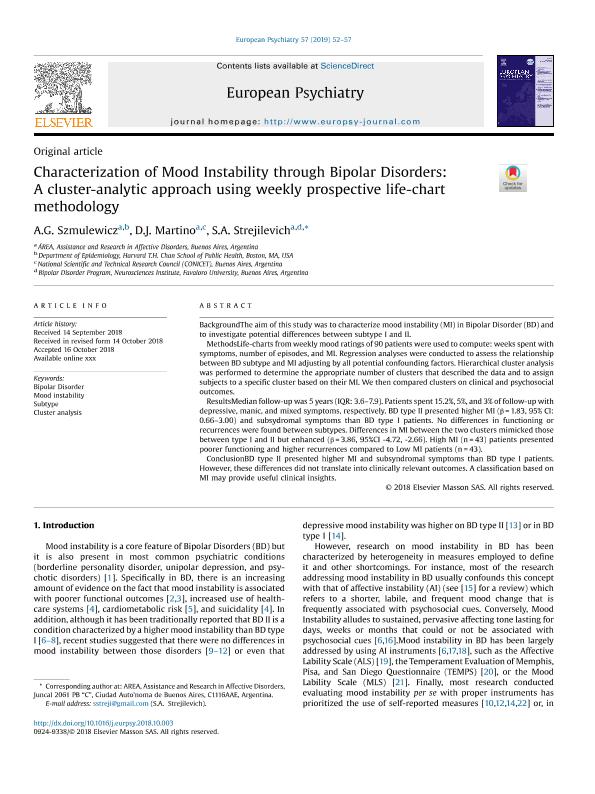Artículo
Characterization of Mood Instability through Bipolar Disorders: A cluster-analytic approach using weekly prospective life-chart methodology
Fecha de publicación:
01/2019
Editorial:
Elsevier France-editions Scientifiques Medicales Elsevier
Revista:
European Psychiatry
ISSN:
1778-3585
e-ISSN:
0924-9338
Idioma:
Inglés
Tipo de recurso:
Artículo publicado
Clasificación temática:
Resumen
BackgroundThe aim of this study was to characterize mood instability (MI) in Bipolar Disorder (BD) and to investigate potential differences between subtype I and II.MethodsLife-charts from weekly mood ratings of 90 patients were used to compute: weeks spent with symptoms, number of episodes, and MI. Regression analyses were conducted to assess the relationship between BD subtype and MI adjusting by all potential confounding factors. Hierarchical cluster analysis was performed to determine the appropriate number of clusters that described the data and to assign subjects to a specific cluster based on their MI. We then compared clusters on clinical and psychosocial outcomes.ResultsMedian follow-up was 5 years (IQR: 3.6?7.9). Patients spent 15.2%, 5%, and 3% of follow-up with depressive, manic, and mixed symptoms, respectively. BD type II presented higher MI (β = 1.83, 95% CI: 0.66?3.00) and subsydromal symptoms than BD type I patients. No differences in functioning or recurrences were found between subtypes. Differences in MI between the two clusters mimicked those between type I and II but enhanced (β = 3.86, 95%CI -4.72, -2.66). High MI (n = 43) patients presented poorer functioning and higher recurrences compared to Low MI patients (n = 43).ConclusionBD type II presented higher MI and subsyndromal symptoms than BD type I patients. However, these differences did not translate into clinically relevant outcomes. A classification based on MI may provide useful clinical insights.
Palabras clave:
BIPOLAR DISORDER
,
CLUSTER ANALYSIS
,
MOOD INSTABILITY
,
SUBTYPE
Archivos asociados
Licencia
Identificadores
Colecciones
Articulos(INCYT)
Articulos de INSTITUTO DE NEUROCIENCIAS COGNITIVAS Y TRASLACIONAL
Articulos de INSTITUTO DE NEUROCIENCIAS COGNITIVAS Y TRASLACIONAL
Citación
Szmulewicz, A.G.; Martino, Diego Javier; Strejilevich, S. A.; Characterization of Mood Instability through Bipolar Disorders: A cluster-analytic approach using weekly prospective life-chart methodology; Elsevier France-editions Scientifiques Medicales Elsevier; European Psychiatry; 57; 1-2019; 52-57
Compartir
Altmétricas




